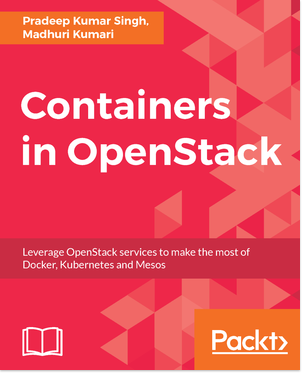OpenStack provides the resources and services that container platforms and applications can rely on but if you’re new to either it can be hard to know where to start. You can build on your knowledge with a book from Packt titled “Containers in OpenStack.”
Authors Pradeep Kumar Singh and Madhuri Kumari promise a practical book to help readers understand how the container ecosystem and OpenStack work together.
Superuser talked to them about building your foundation, Kata containers and how to get more involved in the OpenStack community.

Who will this help most?
The book is essentially for the cloud engineers, system administrators, developers or anyone who is interested in learning about the containers and using them with OpenStack.
Some highlights include:
- Gives thorough idea of how containers evolved, what containers and container orchestration engines are and its different types helpful for all audiences.
- It helps in understanding the architecture and components of all OpenStack container related projects for all audiences.
- Gives a very good understanding of code flow for an example API across different components in all the projects helpful for developers.
- Explains the key features of all the projects.
- Provides detailed steps for setting up a development environment for each project for which helps developers to start off with the projects.
- It also pens down the basic CLIs to start managing resources in all the projects which are useful for all the audiences.
- It also provides list of commands that are useful for cloud administrators to manage services in OpenStack projects.
- Know the best practices for using containers in OpenStack.
What’s the steepest learning curve for people around OpenStack and containers?
We would suggest to get your hands dirty getting into basic container related projects like Docker, Kubernetes. Then you can start with the OpenStack container related projects like Magnum, Zun, Kolla and understand how the containerization is used across different projects.
How have you seen best practices shift over the time you’ve been working with OpenStack?
OpenStack has become mature and stable over a period of time. OpenStack has always evolved supporting newer technologies with a good pace. Initially OpenStack Container Working Group started Magnum project that managed both containers and container orchestration engines. But they felt the importance of having an independent project for managing containers and that’s how Zun evolved. Since then there has been many container related projects which either uses containers for easing the use of OpenStack such as Kolla, OpenStack Helm or support container related technologies such as Kuryr, Fuxi.
You’ve both been core reviewers for OpenStack projects – what’s your advice for people who want to get more involved?
Start small with bugs and then target to blueprints. There are many ways people can get involved in OpenStack, including:
- Subscribe to OpenStack mailing lists (MLs).
- Start with reading the OpenStack project related documents and Wiki pages.
- Attending weekly meetings
- Find some low-hanging or documentation bugs in the projects and try to fix them which helps in understanding the code. If you find it difficult to find bugs, contact PTL or core reviewers to get some help.
- Reviewing code regularly is a very crucial point to understand the project well and becoming a core 🙂
- When you’re confident enough, try to implement blueprints in the projects with laying down a specification document.
- Try to be very responsive to the comments on your commit.
- Feel free to ask questions in IRC, MLs. There are bunch of helpful people available.
Below are some useful links for Zun project. The easiest way to find out about the OpenStack project that interests you is to replace the project name (Zun) with your project name.
OpenStack mailing lists: http://lists.openstack.org/cgi-bin/mailman/listinfo
Wiki: https://wiki.openstack.org/wiki/Zun
Documentation: https://docs.openstack.org/zun/latest/
Bugs: https://bugs.launchpad.net/zun
Blueprints: https://blueprints.launchpad.net/zun
Code: https://github.com/openstack/zun/tree/master/zun
Gerrit: https://review.openstack.org/#/q/project:openstack/zun+status:open
Have either of you had experience using Kata Containers and what are your thoughts about the project?
Madhuri Kumari: Kata Containers seems to be a very promising project… I’ve worked on integrating Clear Containers in OpenStack Zun project [1]. Because Kata containers is Intel Clear Containers + Hyper runV, I am working on integrating it as well with OpenStack Zun. I have an upcoming talk at the OpenStack Vancouver summit on it titled “Integrating Openstack Zun with Kata containers.”
If you want to fill out your bookshelf, remember that the OpenStack Marketplace — your one-stop shop for training, distros, private-cloud-as-a-service and more — offers a selection of technical publications, too. The listings are not affiliate links, but offered as a way to highlight the efforts of community members.
Under the “books” heading, you’ll find titles by Stackers including “Mastering OpenStack,” “OpenStack Networking Essentials,” and “OpenStack: Building a Cloud Environment.”
- OpenStack Homebrew Club: Meet the sausage cloud - July 31, 2019
- Building a virtuous circle with open infrastructure: Inclusive, global, adaptable - July 30, 2019
- Using Istio’s Mixer for network request caching: What’s next - July 22, 2019

)







